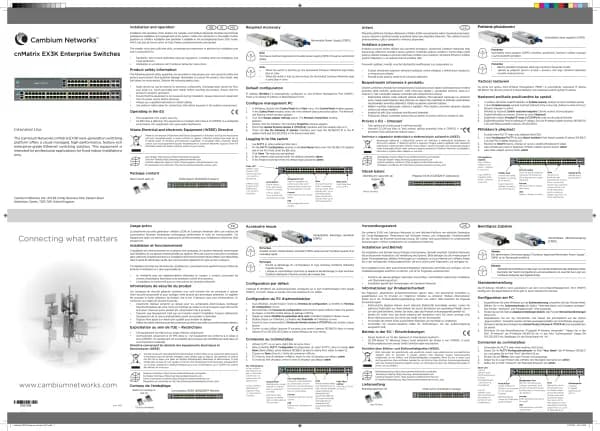Cambium Networks XMS Cloud handleiding
Handleiding
Je bekijkt pagina 17 van 90

device whose MAC address starts with AB:CD:EF. Note that you can use the FF:FF:FF:00:00:00 mask to
select an OUI of a particular device manufacturer.
3. Add Application Control Rules to your policy, if desired. For networks running releases prior to AOS 8.5.6, the
option to create these rules is only displayed if you purchased Application Control licenses for any of your APs.
For each rule, click New Application Control, then fill in the following information (for Advanced options, see Step
4):
n Name: You may enter a descriptive name in this field, or allow XMS- Cloud to automatically create a
descriptive name.
n Enable: You may use this field to enable or disable this rule. If you want to stop enforcing a rule temporarily
and then resume using it, it is more convenient to disable and then re-enable it than to delete the rule and
then re-enter it.
n Action: Choose whether this rule will be an Allow filter or a Block filter. For an Allow filter, any traffic that
meets the filter criteria will be allowed. For a Block filter, any traffic that meets the filter criteria will be
blocked. Note that Advanced Options (Step 4) are only available for “Allow” rules.
n Category/Application: This drop-down list displays applications, organized by a category heading
followed by applications of that type . For example, select the heading All Games Apps to apply this policy
to all games. Or select one of the games listed below the heading, Battle.net for example, to create a rule
for just one game application. At the top of the drop-down list there is a search field that will list any
application whose name includes the string entered in the field. Note that for the XR-320 and X2-120, a
smaller set of applications are available than for larger APs.
Advanced Settings, Scheduling, Editing, and Precedence for Policies
4. Show Advanced—These options allow you to set traffic priority, and traffic and client limits. Which options are
offered depends on the type of policy and/or rule. Since QoS, DSCP, and traffic limits manage traffic handling,
they only apply to entire policies or to Allow rules. They do not apply to Block rules, because when criteria are
met on those rules, no traffic is passed.
n Default QoS: Set packets ingressing from the wired network that match the filter criteria to this QoS level
(0 to 3) before sending them out on the wireless network. Select the level from the pull-down list. Level 0
has the lowest priority; level 3 has the highest priority. By default, this field is blank and the filter does not
modify QoS level. This is very useful for increasing the priority of business-critical applications, while
decreasing the priority of undesirable traffic. For example, you might increase the priority of WebEx, and
decrease the priority of games.
n DSCP (Differentiated Services Code Point or DiffServ—DSCP): Set packets ingressing from the wireless
network that match the filter criteria to this DSCP level (0 to 63) before sending them out on the wired
network. Select the level from the pull-down list. Level 0 has the lowest priority; level 63 has the highest
priority. By default, this field is blank and the filter does not modify DSCP level.
n Limit Traffic: Instead of simply allowing the specified traffic type, you may cap the amount of traffic
allowed that matches this filter. You may set limits on the total of this type of traffic on this SSID for the AP,
and/or per station. Select the units for the limit: Kbps or packets per second (pps). Then enter the limit
quantity in the field to the left.
n Client Count Limit: You may cap the number of clients who can connect to an AP under a policy. For an
SSID policy, you may cap the number of clients on an AP who may connect to this SSID. For a Personal
SSID policy, you may cap the total number of clients on an AP who may connect to all Personal SSIDs. For a
device policy, you may cap the number of clients who may connect to an AP from this kind of device. For a
user group policy, you may cap the number of group members who may connect to this AP. For a global
policy, you may cap the total number of clients who may connect to this AP.
n Station-to-Station Traffic: This setting, only available for the Global policy and SSID policies, blocks or
allows traffic between stations. Used in the Global policy, it applies to all profile member APs. Used in an
17 | Help Guide | XMS Cloud
Bekijk gratis de handleiding van Cambium Networks XMS Cloud, stel vragen en lees de antwoorden op veelvoorkomende problemen, of gebruik onze assistent om sneller informatie in de handleiding te vinden of uitleg te krijgen over specifieke functies.
Productinformatie
| Merk | Cambium Networks |
| Model | XMS Cloud |
| Categorie | Niet gecategoriseerd |
| Taal | Nederlands |
| Grootte | 13480 MB |







